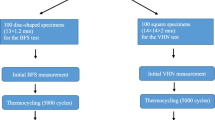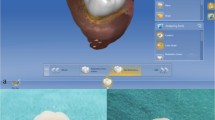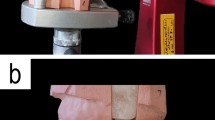Abstract
This in-vitro study aimed to evaluate the fracture strength (FS; N) of composite, feldspathic, and glass–ceramic computer-aided design/computer-aided manufacturing (CAD/CAM) endocrowns after thermomechanical aging. Seventy non-carious human molars were randomly divided into seven groups, according to the CAD/CAM material used for endocrown fabrication. Intact molars without cavity preparations were used as control (n = 10). Following endodontic treatment, standardized endocrown cavities were prepared and endocrowns were fabricated using composite (Cerasmart270, CS and Grandio Blocs, GB), fired and milled zirconia-reinforced lithium silicate (Celtra Duo, CD), leucite-reinforced feldspar ceramic (LRF Initial, LRF), and feldspathic (Cerec Blocks, CE) materials which were luted with universal adhesive (Futurabond U; Voco) and dual-cure resin cement (Bifix QM). Following thermocycling for 20,000 cycles and 480,000 load cycles in a chewing simulator (CS-4.2, SD Mechatronik), FS was evaluated (Instron). Data were analyzed with one-way ANOVA and post hoc Tukey’s tests (p < 0.05). FS was significantly influenced by the tested material (p = 0.00). CS had the highest FS, which was not significantly different from intact molars and fired CD (p > 0.05). There were no significant differences in FS between LRF, GB, and CD, which were significantly higher than CE. Most of the failure modes of CS, CD, and GB were repairable, whereas those of CE were irreparable. All the tested materials withstood clinically relevant axial forces. Composite endocrowns exhibited more favorable fracture pattern, whereas feldspathic and leucite-reinforced feldspar ceramic endocrowns exhibited mostly irreparable fractures.










Similar content being viewed by others
References
Mannocci F, Bitter K, Sauro S, Ferrari P, Austin R, Bhuva B. Present status and future directions: the restoration of root filled teeth. Int Endod J. 2022;55(Suppl 4):1059–84.
Dietschi D, Bouillaguet S, Avishai S. Restoration of the endodontically treated tooth. Cohen’s pathways of the pulp (Tenth Edition) 2011, In: Cohen’s Pathways of the pulp. Mosby, p. 777–807
Ree M, Schwartz RS. The endo-restorative interface: current concepts. Dent Clin North Am. 2010;54(2):345–74.
Olcay K, Ataoglu H, Belli S. Evaluation of related factors in the failure of endodonticallytreated teeth: a cross-sectional study. J Endod. 2018;44(1):38–45.
Fuss Z, Lustig J, Tamse A. Prevalence of vertical root fractures in extracted endodontically treated teeth. Int Endod J. 1999;32(4):283–6.
Sarkis-Onofre R, Pereira-Cenci T, Opdam NJ, Demarco FF. Preference for using posts to restore endodontically treated teeth: findings from a survey with dentists. Braz Oral Res. 2015;29:1–6.
Girotto LPS, Dotto L, Pereira GKR, Bacchi A, Sarkis-Onofre R. Restorative preferences and choices of dentists and students for restoring endodontically treated teeth: a systematic review of survey studies. J Prosthet Dent. 2021;126(4):489-489.e5.
Soares CJ, Valdivia AD, da Silva GR, Santana FR, Menezes MS. Longitudinal clinical evaluation of post systems: a literature review. Braz Dent J. 2012;23(2):135–740.
Gómez-Polo M, Llidó B, Rivero A, Del Río J, Celemín A. A 10-year retrospective study of the survival rate of teeth restored with metal prefabricated posts versus cast metal posts and cores. J Dent. 2010;38:916–20.
Jung RE, Kalkstein O, Sailer I, Roos M, Hämmerle CH. A comparison of composite post buildups and cast gold post-and- core buildups for the restoration of nonvital teeth after 5 to 10 years. Int J Prosthodont. 2007;20:63–9.
Ferrari M, Vichi A, Garcia-Godoy F. Clinical evaluation of fiber-reinforced epoxy resin posts and cast post and cores. Am J Dent. 2000;13:15B-18B.
Bindl A, Mörmann WH. Clinical evaluation of adhesively placed Cerec endocrowns after 2 years–preliminary results. J Adhes Dent. 1999;1(3):255–65.
Salvi GE, Siegrist Guldener BE, Amstad T, Joss A, Lang NP. Clinical evaluation of root filled teeth restored with or without post-and-core systems in a specialist practice setting. Int Endod J. 2007;40(3):209–15.
Zogheib LV, Saavedra Gde S, Cardoso PE, Valera MC, Araújo MA. Resistance to compression of weakened roots subjected to different root reconstruction protocols. J Appl Oral Sci. 2011;19(6):648–54.
Fernandes AS, Dessai GS. Factors affecting the fracture resistance of post-core reconstructed teeth: a review. The Int J Prosthodont. 2001;14(4):355–63.
Tan PL, Aquilino SA, Gratton DG, Stanford CM, Tan SC, Johnson WT, Dawson D. In vitro fracture resistance of endodontically treated central incisors with varying ferrule heights and configurations. J Prosthetic Dent. 2005;93:331–6.
Naumann M, Schmitter M, Krastl G. Postendodontic restoration: endodontic post-and-core or no post at all? J Adhes Dent. 2018;20:19–24.
Newman MP, Yaman P, Dennison J, Rafter M, Billy E. Fracture resistance of endodontically treated teeth restored with composite posts. J Prosthet Dent. 2003;89:360–7.
Belli S, Erdemir A, Yildirim C. Reinforcement effect of polyethylene fiber in root-filled teeth: comparison of two restoration techniques. Int Endod J. 2006;39(2):136–42.
Chang YH, Lin WH, Kuo WC, Chang CY, Lin CL. Mechanical interactions of cuspal-coverage designs and cement thickness in a cusp-replacing ceramic premolar restoration: a finite element study. Med Biol Eng Comput. 2009;47:367–74.
Pissis P. Fabrication of a metal-free ceramic restoration utilizing the monobloc technique. Pract Periodontics Aesthet Dent. 1995;7(5):83–94.
Sedrez-Porto JA, Rosa WL, da Silva AF, Münchow EA, Pereira-Cenci T. Endocrown restorations: a systematic review and meta-analysis. J Dent. 2016;52:8–14.
Bindl A, Richter B, Mörmann WH. Survival of ceramic computer-aided design/manufacturing crowns bonded to preparations with reduced macroretention geometry. Int J Prosthodont. 2005;18:219–24.
Eskitaşçioğlu M, Küçük O, Eskitaşçioğlu G, Eraslan O, Belli S. The effect of different materials and techniques on stress distribution in CAD/CAM endocrowns. Strength Mater. 2020;52:812–9.
Chersoni S, Lorenzi R, Ferrieri P, Prati C. Laboratory evaluation of compomers in Class V restorations. Am J Dent. 1997;10:147–51.
El-Damanhoury HM, Haj-Ali RN, Platt JA. Fracture resistance and microleakage of endocrowns utilizing three CAD-CAM blocks. Oper Dent. 2015;40:201–10.
Ghajghouj O, Taşar-Faruk S. Evaluation of fracture resistance and microleakage of endocrowns with different intracoronal depths and restorative materials luted with various resin cements. Materials (Basel). 2019;12(16):2528.
Kirkpatrick JJ, Enion DS, Burd DA. Hydrofluoric acid burns: a review. Burns. 1995;21(7):483–93.
Lührs AK, Pongprueksa P, De Munck J, Geurtsen W, Van Meerbeek B. Curing mode affects bond strength of adhesively luted composite CAD/CAM restorations to dentin. Dent Mater. 2014;30(3):281–91.
Gresnigt MM, Özcan M, van den Houten ML, Schipper L, Cune MS. Fracture strength, failure type and Weibull charac- teristics of lithium disilicate and multiphase resin composite endocrowns under axial and lateral forces. Dent Mater. 2016;32(5):607–14.
de Kuijper MCFM, Cune MS, Tromp Y, Gresnigt MM. Cyclic loading and load to failure of lithium disilicate endocrowns: Influence of the restoration extension in the pulp chamber and the enamel outline. J Mech Behav Biomed Mater. 2020;105: 103670.
El-Damanhoury HM, Haj-Ali RN, Platt JA. Fracture resistance and microleakage of endocrowns utilizing three CAD-CAM blocks. Oper Dent. 2015;40(2):201–10.
Altier M, Erol F, Yildirim G, Dalkilic EE. Fracture resistance and failure modes of lithium disilicate or composite endocrowns. Niger J Clin Pract. 2018;21:821–6.
Aktas G, Yerlikaya H, Akca K. Mechanical failure of endocrowns manufactured with different ceramic materials: an in vitro biomechanical study. J Prosthodont. 2016;27:340–6.
Braun S, Bantleon HP, Hnat WP, Freudenthaler JW, Marcotte MR, Johnson BE. A study of bite force, part 2: relationship to various cephalometric measurements. Angle Orthod. 1995;65(5):373–7.
Waltimo A, Kemppainen P, Könönen M. Maximal contraction force and endurance of human jaw-closing muscles in isometric clenching. Scand J Dent Res. 1993;101(6):416–21.
Jansen van Vuuren L, Jansen van Vuuren WA, Broadbent JM, Duncan WJ, Waddell JN. Development of a bite force transducer for measuring maximum voluntary bite forces between individual opposing tooth surfaces. J Mech Behav Biomed Mater 2020;109:103846.
Varga S, Spalj S, Lapter Varga M, Anic Milosevic S, Slaj M. Maximum voluntary molar bite force in subjects with normal occlusion. Eur J Orthod. 2011;33(4):427–33.
Sağlam G, Cengiz S, Karacaer Ö. Marginal adaptation and fracture strength of endocrowns manufactured with different restorative materials: SEM and mechanical evaluation. Microsc Res Tech. 2021;84(2):284–90.
Taha D, Spintzyk S, Sabet A, Wahsh M, Salah T. Assessment of marginal adaptation and fracture resistance of endocrown restorations utilizing different machinable blocks subjected to thermomechanical aging. J Esthet Restor Dent. 2018;30(4):319–28.
Furtado de Mendonca A, Shahmoradi M, Gouvêa CVD, De Souza GM, Ellakwa A. Microstructural and mechanical characterization of CAD/CAM materials for monolithic dental restorations. J Prosthodont 2019; 28(2):e587–e594.
Yano HT, Ikeda H, Nagamatsu Y, Masaki C, Hosokowa R, Shimizu H. Correlation between microstructure of CAD/CAM composites and the silanization effect on adhesive bonding. J Mech Behav Bio Sci. 2020;101:1–8.
Lauvahutanon S, Takahashi H, Shiozawa M, Iwasaki N, Oki M, Finger WJ, Arksornnukit M. Mechanical properties of composite resin blocks for CAD/CAM. Dent Mater J. 2014;33(5):705–10.
Alamoush RA, Silikas N, Salim NA, Al-Nasrawi S, Satterthwaite JD. Effect of the composition of CAD/CAM composite blocks on mechanical properties. Biomed Res Int. 2018;23:4893143.
Awada A, Nathanson D. Mechanical properties of resin- ceramic CAD/CAM restorative materials. J Prosthet Dent. 2015;114:587–93.
Bankoğlu Güngör M, Turhan Bal B, Yilmaz H, Aydin C, Karakoca NS. Fracture strength of CAD/CAM fabricated lithium disilicate and resin nano ceramic restorations used for endodontically treated teeth. Dent Mater J. 2017;36(2):135–41.
Sary SB, Samah MS, Walid AZ. Effect of restoration technique on resistance to fracture of endodontically treated anterior teeth with flared root canals. J Biomed Res. 2019;33:131–8.
Ruse ND, Sadoun MJ. Resin-composite blocks for dental CAD/CAM applications. J Dent Res. 2014;93(12):1232–4.
Govare N, Contrepois M. Endocrowns: A systematic review. J Prosthet Dent. 2020;123:411–8.
Corado HPR, da Silveira PHPM, Ortega VL, Ramos GG, Elias CN. Flexural strength of vitreous ceramics based on lithium disilicate and lithium silicate reinforced with zirconia for CAD/CAM. Int J Biomater. 2022. https://doi.org/10.1155/2022/5896511.
D’Arcangelo C, Vanini L, Rondoni GD, De Angelis F. Wear properties of dental ceramics and porcelains compared with human enamel. J Prosthet Dent. 2016;115(3):350–5.
Zimmermann M, Egli G, Zaruba M, Mehl A. Influence of material thickness on fractural strength of CAD/CAM fabricated ceramic crowns. Dent Mater J. 2017;36(6):778–83.
Kruzic JJ, Arsecularatne JA, Tanaka CB, Hoffman MJ, Cesar PF. Recent advances in understanding the fatigue and wear behavior of dental composites and ceramics. J Mech Behav Biomed Mater. 2018;88:504–33.
Shin Y, Park S, Park JW, Kim KM, Park YB, Roh BD. Evaluation of the marginal and internal discrepancies of CAD-CAM endocrowns with different cavity depths: an in vitro study. J Prosthet Dent. 2017;117(1):109–15.
Keuleman F, Garoushi S, Lassila L. Fillings and core builtups (Book Chapter). In: Vallittu, Özcan M (eds) A clinical guide to principles of fibre reinforced composites (FCRs) in dentistry. Woodhead Publishing: 2017.
Eichelsbacher F, Denner W, Klaiber B, Schlagenhauf UJ. Periodontal status of teeth with crown -root fractures: results two years after adhesive fragment reattachment. Clin Periodontol. 2009;36(10):905–11.
Soares CJ, Pizi EC, Fonseca RB, Martins LR. Influence of root embedment material and periodontal ligament simulation on fracture resistance tests. Braz Oral Res. 2005;19:11–6.
Magne P, Schlichting LH, Paranhos MP. Risk of onlay fracture during pre-cementation functional occlusal tapping. Dent Mater. 2011;27:942–7.
Author information
Authors and Affiliations
Corresponding author
Ethics declarations
Conflict of interest
The authors have no financial interest in any of the companies whose products are used in this study. This manuscript has been read and approved by all the authors.
Additional information
Publisher's Note
Springer Nature remains neutral with regard to jurisdictional claims in published maps and institutional affiliations.
Supplementary Information
Below is the link to the electronic supplementary material.
Rights and permissions
Springer Nature or its licensor (e.g. a society or other partner) holds exclusive rights to this article under a publishing agreement with the author(s) or other rightsholder(s); author self-archiving of the accepted manuscript version of this article is solely governed by the terms of such publishing agreement and applicable law.
About this article
Cite this article
Dikici, B., Can, E., Türkeş Başaran, E. et al. Fracture strength of endocrowns after thermomechanical aging. Odontology (2024). https://doi.org/10.1007/s10266-023-00884-z
Received:
Accepted:
Published:
DOI: https://doi.org/10.1007/s10266-023-00884-z




